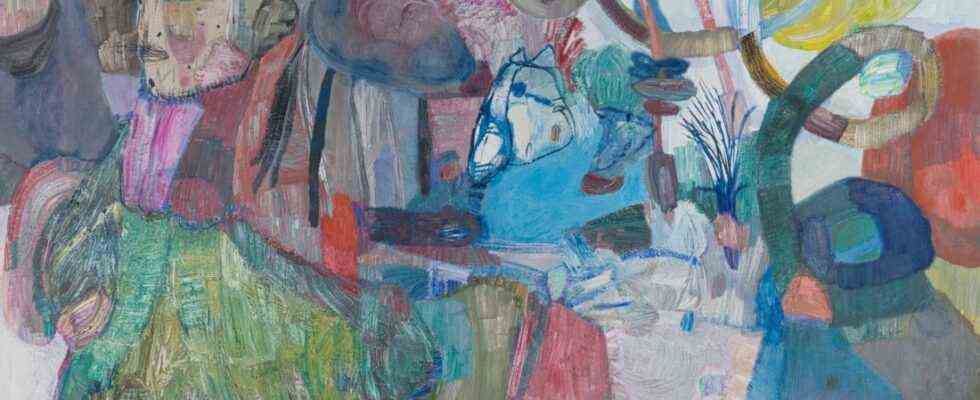The contrast is great. Here the poet Marieluise Fleißer with her strict, laconic artistic language, there the painter Annette Lucks with her idiosyncratic, enigmatic cosmos of images. In contrast to Fleißer’s work, everything remains in suspension, perspectives diverge, felt and thought flow into one another. There is no beginning, no end. And yet Annette Lucks manages to encounter the writer in her pictures. The exhibition in Marieluise Fleißer House in Ingolstadt.
The house where the writer was born (1901-1974), a narrow building on Kupferstrasse, was only reopened in October 2020 after a major renovation. The documentation center, which is limited to the ground floor, has been transformed into a veritable museum. A blacksmith’s workshop on the ground floor reminds us that “the hard worker”, as Bert Brecht called her in his letters, was the daughter of an ironmonger and kit maker. One floor up, six wonderfully staged main themes – talent, success, isolation, men, recognition and language – circle the life of the writer with many voices. On the second floor, the place for special exhibitions and events, one encounters Annette Luck’s collages, installations and wedding plates. Seems to be an insider tip, because the city, in contrast to the Diligent society not a single syllable referring to the exhibition on their museum website.
“Blue Flowers” by Annette Lucks, a collage in which the artist bundles very different techniques.
(Photo: Norbert Eberle, VG Bildkunst Bonn 2021)
It was the poet’s directness that fascinated Lucks in the 1970s when she saw her play “The Strong Trunk” while studying with the surrealist Mac Zimmermann in the Residenztheater. “I was flat out, this language, so precise, so solid. And the unbelievable realism, the ruthlessness.” This experience had no impact on my own work. At least that’s what Lucks thought at the time. In general, the artist, born in Regensburg in 1952, was still of the opinion in those years that literature could not inspire her to create pictures. Until one day she read Djuna Barnes’ “Nachtgewächs” and immediately created a whole cycle of works for it. It’s just a shame that no publisher wanted it, not even Faber & Faber. But the Leipzig publisher asked Lucks whether she would like to try the stories by Marieluise Fleißer? “At first I thought I couldn’t do it,” recalls Lucks. Even so, she read the stories, over and over again, “mantra-like”. First small heads and figures appeared, then other images. The novella edition “A pound of oranges and nine other stories” (1995) was finally printed with forty of her drawings and three lithographs. The Book Art Foundation counted it among the most beautiful books in Germany in 1996 and awarded it a prize.
Since then, Lucks has never completely lost sight of the writer. The opening of the museum gave her the opportunity to “return to the company of the poet” (Lucks). She says it is not a dialogue, “that would be too strong a word, it sounds as if I wanted to get hold of it”. She stops in front of “Marie” in the first room. A large female figure slides towards the viewer, alongside thick garlands of color, but also sketchily sketched trees and faces. Or are they mythical creatures that stand out in the undergrowth of lines? The complex works resist one-dimensional readings.
In the collage “A Fan from Women” (2019), Annette Lucks worked with ink, oil and wax and used fragments of woodcuts and etchings.
(Photo: Norbert Eberle, VG Bildkunst Bonn 2021)
Lucks also offers no explanations on how to navigate their mazes. To do this, she quotes a sentence by the writer Siri Hustvedt: “Reading is embodied action.” Which also applies to reading collages. The viewer has to step into multi-layered, ambivalent worlds, meander between figures, animals, plants and discover the path “From Marie to Luise”, the title of the exhibition, for himself.
Signs, Metaphors, and Quotes
Is there a literary or a biographical point of reference at the beginning of a collage? Lucks shakes his head. “At first I don’t think anything, I read and suddenly come across a sentence that knocks me out.” And triggers associations or memories. Signs, metaphors, and quotations are layered in her work. Wide, impasto color strips stand next to spontaneous-looking doodles – “I find it appealing when different rooms are created,” says Lucks. Often appearances remain shadowy, shapes are only hinted at. Fact and fiction, contradicting and vague are mixed up. The painter and graphic artist cannot be determined technically either. She paints with oil, watercolors or wax, cuts fragments from old etchings, and glues them into new contexts in a modified form. Fleißer’s penchant for fabrics and hats inspired Lucks, stimulating her to wear green turbans, red top hats and caps, and threateningly alienated Black Forest hats.
It is fascinating to see how Lucks succeeds in creating a dense network of association fragments. And also to meet her chosen relative Marieluise Fleißer again and again.
Annette Lucks: From Marie to Luise – a collage, until January 30th, Marie-Luise-Fleißer-Haus, Ingolstadt, Kupferstrasse 18. A catalog has been published for the exhibition.

